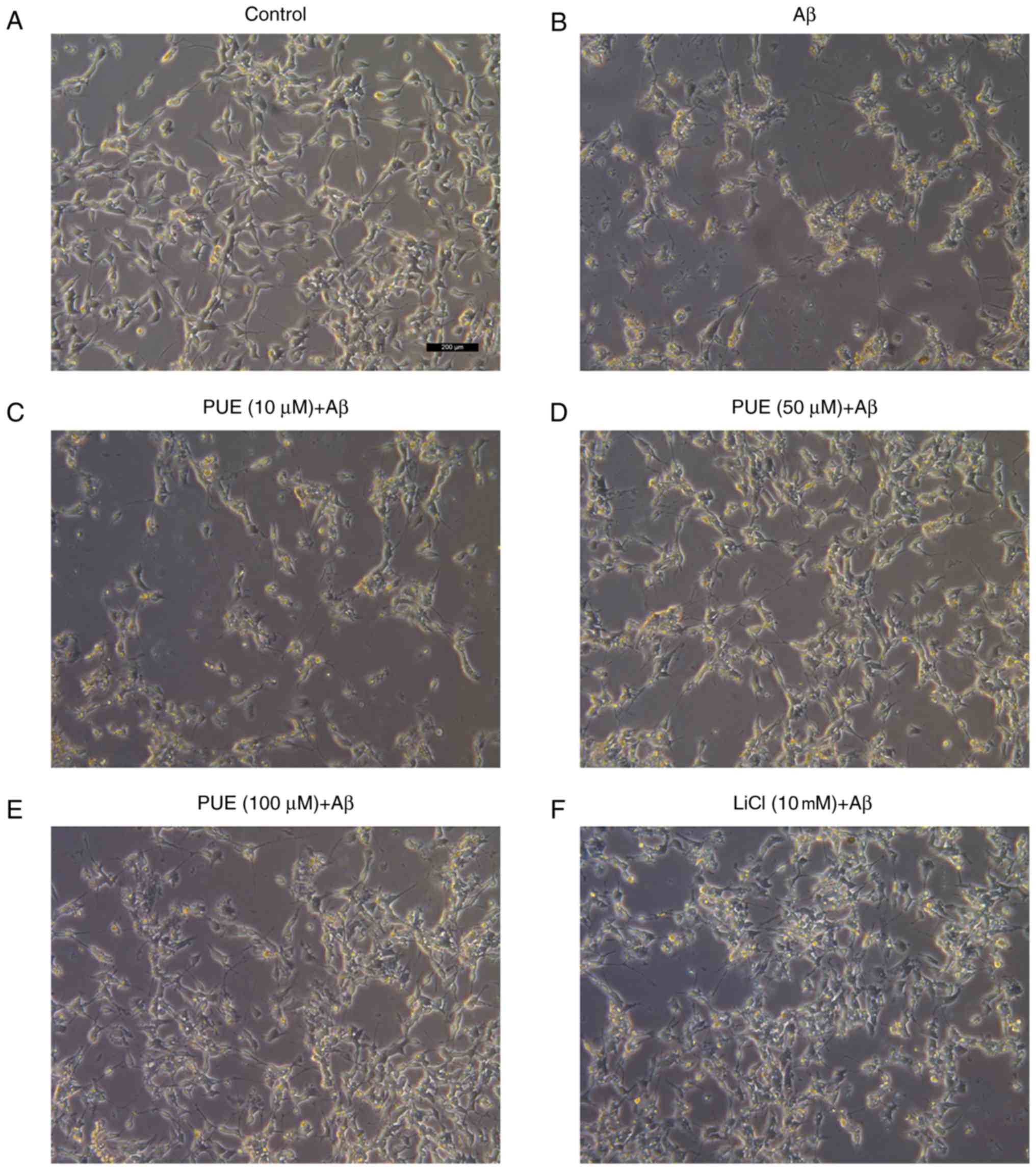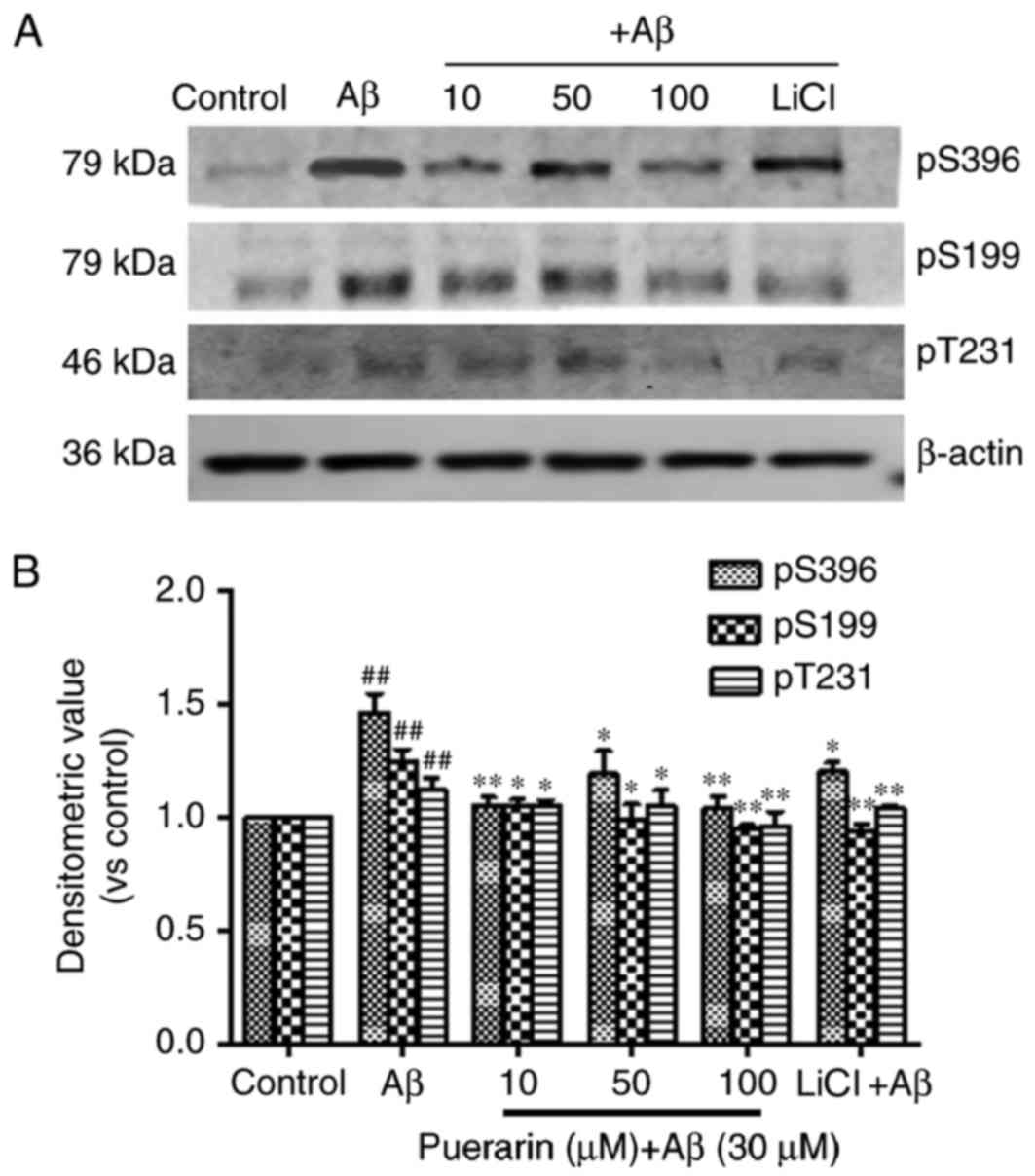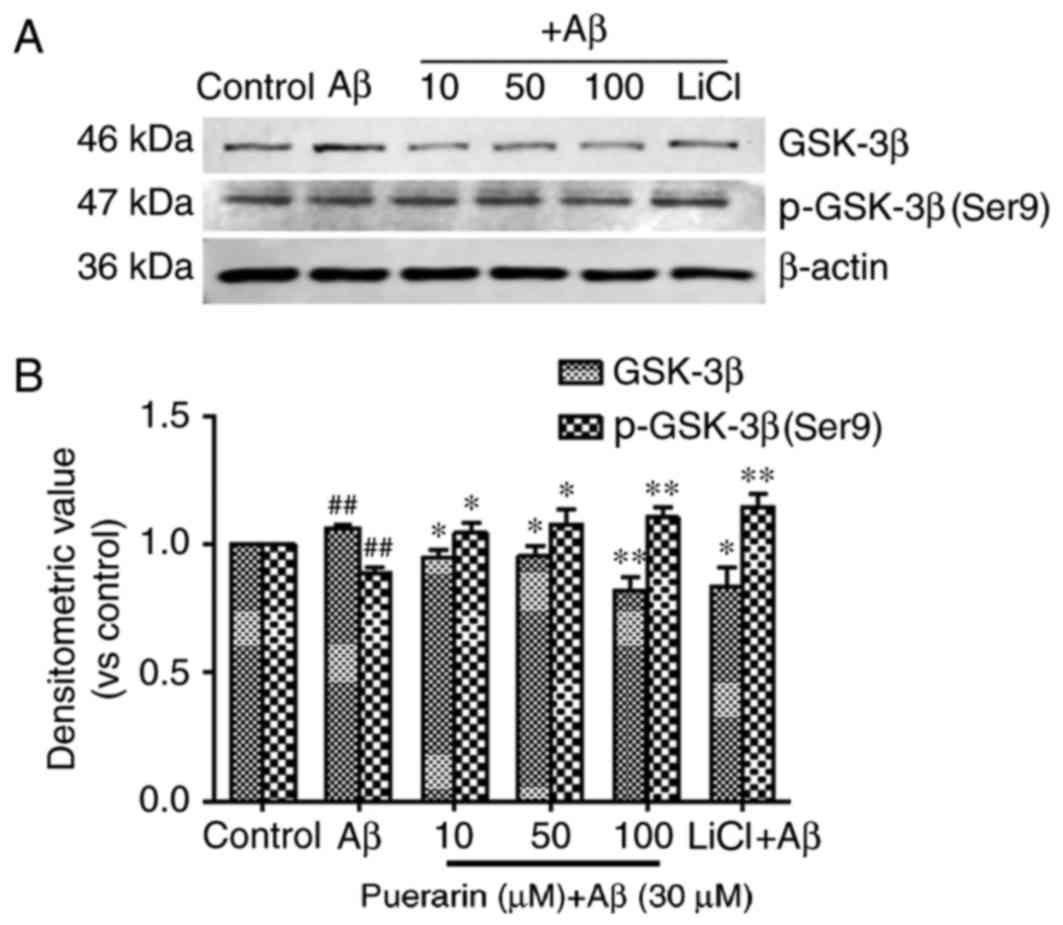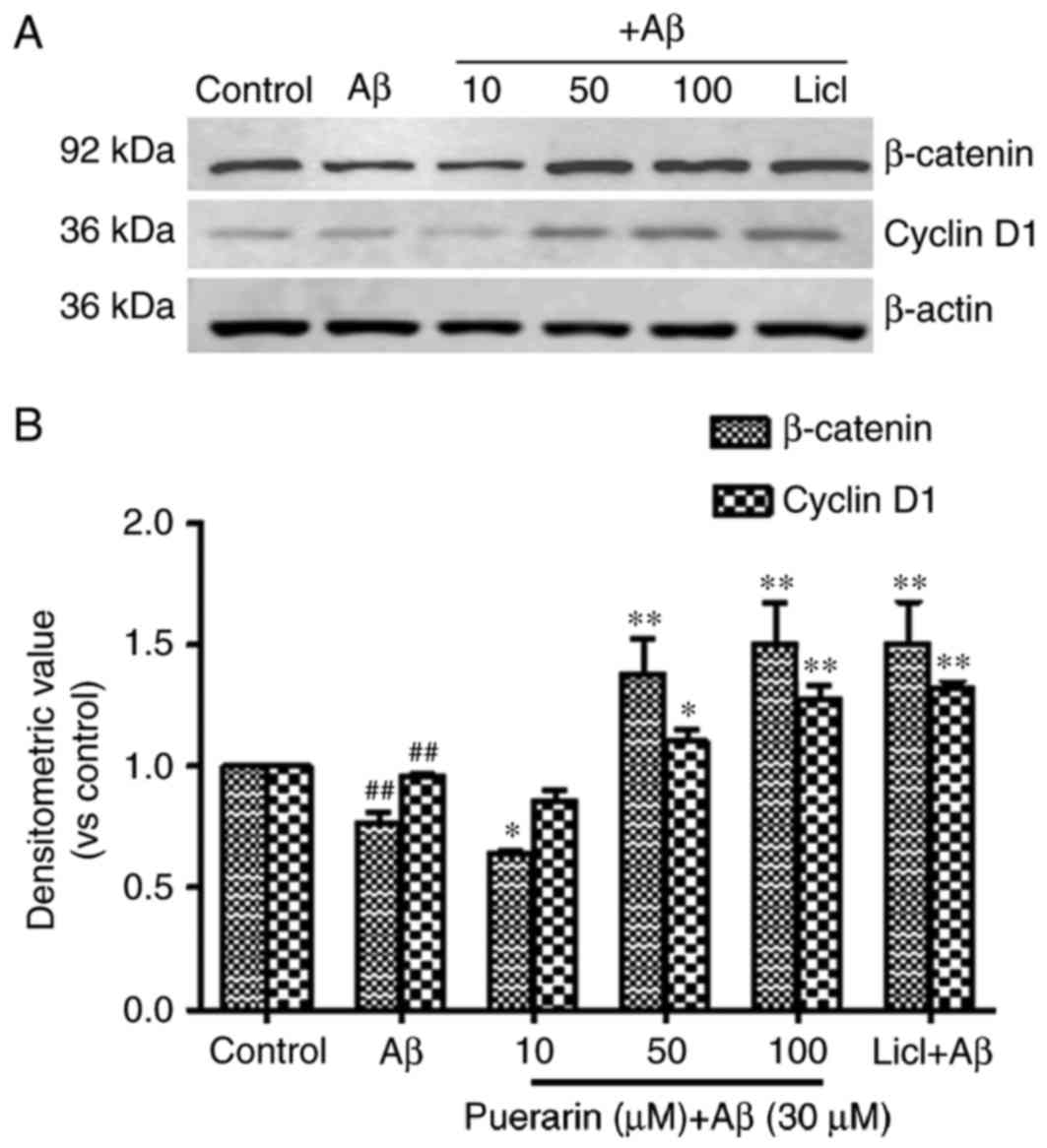Puerarin inhibits β‑amyloid peptide 1‑42‑induced tau hyperphosphorylation via the Wnt/β‑catenin signaling pathway
- Authors:
- Published online on: October 3, 2017 https://doi.org/10.3892/mmr.2017.7702
- Pages: 9081-9085
Abstract
Introduction
Alzheimer's disease (AD), also known as senile dementia, is a degenerative disease of the central nervous system that is predominantly characterized by progressive degeneration of cognitive function and memory loss. Previous studies have suggested that disorders of the Wnt/β-catenin signaling pathway in the brains of patients with AD may be associated with pathological alterations (1,2), including formation of neurofibrillary tangles (NFTs) involving neurites and phosphorylated tau proteins, and neuronal loss and senile plaques triggered by β-amyloid peptide (Aβ) accumulation. The Wnt/β-catenin signaling pathway may therefore be considered the core pathway linking Aβ neurotoxicity with tau hyperphosphorylation.
Glycogen synthase kinase (GSK)-3β is a multifunctional serine/threonine kinase and a negative regulator of Wnt/β-catenin signaling. Its abnormal expression is closely associated with the pathogenesis, pathological manifestations and treatment of AD (2). Previous studies have suggested that GSK-3β is a protein kinase that may induce abnormal tau phosphorylation in the brains of patients with AD and phosphorylation of tau at numerous sites (3,4).
Puerarin is the main active ingredient derived from the Chinese herb root of Pueraria lobata, which is a selective inhibitor of GSK-3β (5,6). Previous research has indicated that puerarin downregulates Aβ expression in the brain, inhibits the abnormal expression of tau protein induced by Aβ, reduces cellular apoptosis, and improves learning and memory in animals (7–10). Puerarin exhibits anti-AD activity by inhibiting the activity of GSK-3β and activating the Wnt/β-catenin signaling pathway. At present, it is unknown whether puerarin ameliorates AD via the Wnt/β-catenin signaling pathway. Therefore, the present study aimed to investigate the role of oligomeric peptide Aβ1-42 in SH-SY5Y cell impairment, and the inhibitory effects of puerarin on tau hyperphosphorylation via the Wnt/β-catenin pathway.
Materials and methods
Drugs and reagents
The SH-SY5Y human neuroblastoma cell line was obtained from the Chinese Academy of Sciences, Kunming Cell Biological Research Institute (Kunming, China), and was used in the present study. Oligomeric peptide Aβ1-42 (cat no. 107761-42-2) was purchased from GL Biochem (Shanghai), Ltd. (Shanghai, China) and puerarin (2 ml; 100 mg; 130,803) was obtained from Zhejiang CONBA Pharmaceutical Co., Ltd. (Zhejiang, China). The reagents used were as follows: anhydrous lithium chloride (LiCl; cat no. 213233; Sigma-Aldrich; Merck KGaA, Darmstadt, Germany), Dulbecco's modified Eagle's medium (DMEM; high glucose), and fetal bovine serum (FBS; Gibco; Thermo Fisher Scientific, Inc., Waltham, MA, USA). The following antibodies were used: Rabbit anti-phosphorylated (p)-tau (Ser396; cat no. ab109390), rabbit anti-p-tau (Ser199; cat no. ab81268), rabbit anti-p-tau (Tau231; cat no. ab151559), rabbit anti-β-catenin (cat no. ab32572), rabbit anti-GSK-3β (cat no. ab32391), rabbit anti-p-GSK-3β (Ser9; cat no. ab75814), rabbit monoclonal anti-cyclin D1 (cat no. ab134175), mouse anti-β-actin (cat no. ab179467) (all from Abcam, Cambridge, MA, USA), goat anti-rabbit IgG (H+L) highly cross-adsorbed Alexa Fluor® Plus 555-conjugated secondary antibody (cat no. A32732) and goat anti-mouse IgG (H+L) highly cross-adsorbed Alexa Fluor® Plus 555-conjugated secondary antibody (cat no. A32727) (both from Invitrogen; Thermo Fisher Scientific, Inc.).
Cell culture and treatment
SH-SY5Y cells were cultured in DMEM (high glucose) supplemented with 10% heat-inactivated FBS, 100 µg/ml penicillin and 100 µg/ml streptomycin at 37°C in a humidified incubator containing 5% CO2. Cells were passaged once every 5–7 days, and cells in the logarithmic growth period were obtained.
MTT assay
The MTT assay was used to evaluate cell survival as a function of mitochondrial viability; the following procedure was performed at 37°C. SH-SY5Y cells were subcultured in 96-well plates at a density of 5×105 cells/ml/well. After 24 h attachment, cells were treated with 10, 50, 100 and 150 µmol/l puerarin. Following a 24 h pretreatment with puerarin, 30 µmol/l oligomeric peptide Aβ1-42 was added to the wells and the plate was cultured for a further 24 h. Subsequently, 20 µl MTT (5 mg/ml PBS stock solution) was added to each well and the cells were incubated for 4 h at 37°C, after which, the medium was removed and the cells were treated with 150 µl DMSO. The culture plate was gently agitated until the crystals were completely dissolved, and optical density values were measured at 540 nm using a microplate reader and the inhibitory ratio of cell proliferation was calculated.
Cell morphological analysis
SH-SY5Y cells in the logarithmic growth phase were seeded at a density of 5×105 cells/ml/well in a 6-well plate. Cells were divided into the following groups: The control group, the AD model group (30 µmol/l Aβ1-42), the puerarin treatment groups (10, 50 or 100 µmol/l), and the positive control group (10 mmol/l LiCl). After cell attachment on day 2, the medium in the 6-well plate was removed. Serum-free DMEM was added to the control and AD model groups; DMEM with puerarin, at a final concentration of 10, 50 and 100 µmol/l, was added to the drug treatment groups; and DMEM combined with LiCl at a final concentration of 10 mmol/l was added to the positive control group; 50 µl was added per well for all groups. After 24 h, with the exception of the control group, 30 µmol/l Aβ1-42 was added to the remaining groups. After culturing for a further 24 h, cell morphology was observed under an inverted fluorescence microscope. All procedures described were performed at 37°C.
Protein expression detection by western blotting
Cells were treated as aforementioned. Subsequently, the medium was removed and cells were washed twice with pre-cooled PBS. Radioimmunoprecipitation assay lysis buffer [50 mM Tris (pH 7.4), 150 mM NaCl, 1% Triton X-100, 1% sodium deoxycholate, 0.1% SDS, 2 mM sodium pyrophosphate, 25 mM β-glycerophosphate, 1 mM EDTA, 1 mM Na3VO4 and 0.5 mg/ml leupeptin; 200 µl) was added to each well and the cells were lysed for 30 min over ice. The cell lysates were then centrifuged at 12,000 × g for 15 min at 4°C, the supernatants were collected, and protein content was quantified using the bicinchoninic acid method. Equal protein samples (20 µg) from each group were separated by 10% SDS-PAGE and were transferred to polyvinylidene fluoride membranes by semi-dry transfer. The membranes were then blocked with 5% non-fat milk for 2 h at room temperature, after which the membranes were incubated with the following primary antibodies at 4°C overnight: Rabbit anti-p-tau (Ser396; 1:10,000), rabbit anti-p-tau (Ser199; 1:5,000), rabbit anti-p-tau (Thr231; 1:1,000), rabbit anti-β-catenin (1:5,000), rabbit anti-GSK-3β (1:10,000), rabbit anti-p-GSK-3β (Ser9; 1:10,000) and rabbit anti-cyclin D1 (1:10,000); β-actin (1:10,000) served as an internal control. After washing the membranes with TBS containing 20% Tween-20 (TBST), Alexa Fluor® Plus 555-conjugated secondary antibodies (1:1,000) were added to the membranes and incubated for 1.5 h in the dark at 37°C. Blots were visualized using chemiluminescence (Invitrogen; Thermo Fisher Scientific, Inc.) and were exposed to radiographic films. The same experiment was repeated three times. Density of the bands was measured and analyzed using a gel electrophoresis image analyzer (GS-900™ Calibrated Densitometer with integrated Image Lab™ v6.0 software; cat no. 1707991; Bio-Rad Laboratories, Inc., Hercules, CA, USA), and are expressed as the absorbance ratio of the target protein to the internal control.
Statistical analysis
Data are presented as the mean ± standard deviation. SPSS 17.0 (SPSS, Inc., Chicago, IL, USA) and GraphPad Prism 5 (GraphPad Software, Inc., La Jolla, CA, USA) were used to conduct statistical analyses. Data were statistically analyzed using one-way analysis of variance, with either the Kruskal-Wallis H, the least significant difference or the Games-Howell post hoc tests depending on the data. P<0.05 was considered to indicate a statistically significant difference.
Results
Effects of puerarin on the viability of Aβ1-42-treated SH-SY5Y cells
As presented in Fig. 1, 30 µmol/l Aβ1-42 significantly reduced the viability of SH-SY5Y cells compared with the control group (P<0.01). However, treatment with puerarin (10, 50, 100 and 150 µmol/l) significantly enhanced the viability of SH-SY5Y cells in a dose-dependent manner, compared with the Aβ group (P<0.05). These results suggested that puerarin may inhibit Aβ1-42-induced decreases in SH-SY5Y cell viability and exert a cytoprotective effect.
Effects of puerarin on the growth of Aβ1-42-treated SH-SY5Y cells
As presented in Fig. 2, cells in the control group were normal with high refraction, clearly visible axons and adherence, when observed under an inverted microscope. A day after the addition of Aβ1-42 to the model group, cell diopter was degraded, cell processes were significantly shortened or broken, and the cell number was decreased. Cell morphology in the puerarin (10, 50 and 100 µmol/l) + Aβ group was markedly improved compared with that of the model group. Puerarin inhibited the loss of cellular synapse, and partially enhanced cell diopter and number in a dose-dependent manner. The effects of puerarin (50 µmol/l) were comparable to those of LiCl, thus indicating that various doses of puerarin protected SH-SY5Y cells from Aβ1-42-induced damage.
Effects of puerarin on tau protein phosphorylation in Aβ1-42-treated SH-SY5Y cells
As presented in Fig. 3, compared with the control group, the levels of tau phosphorylation at Ser396, Ser199 and Thr231 sites were significantly increased in the AD model group (P<0.01). Conversely, the levels of tau phosphorylation in the puerarin and LiCl groups were much lower than in the model group (P<0.05). The levels of tau phosphorylation were most significantly decreased following pretreatment with 100 µmol/l puerarin. Therefore, a specific dose of puerarin, similar to that of the GSK-3β inhibitor LiCl, inhibited tau hyperphosphorylation in Aβ-treated SH-SY5Y cells.
Effects of puerarin on the expression of GSK-3β and p-GSK-3β (Ser9) in Aβ1-42-treated SH-SY5Y cells
As shown in Fig. 4, treatment of SH-SY5Y cells with Aβ1-42 for 24 h significantly reduced the levels of GSK-3β phosphorylation at Ser9 (the inhibitory phosphorylated site) (P<0.01) and significantly increased the expression levels of GSK-3β compared with the control group (P<0.01). The expression levels of p-GSK-3β (Ser9) in the SH-SY5Y cells following treatment with puerarin and LiCl were significantly increased compared with in the model group (P<0.05); however, GSK-3β expression was significantly decreased compared with the model group. A reduction in GSK-3β expression and an increase in p-GSK-3β (Ser9) expression were most prominent following pretreatment with 100 µmol/l puerarin, thus suggesting that puerarin increased p-GSK-3β (Ser9)-mediated inhibition of GSK-3β, and GSK-3β mediated Aβ1-42-induced tau phosphorylation.
Effects of puerarin on the expression of β-catenin and cyclin D1 in Aβ1-42-treated SH-SY5Y cells
As presented in Fig. 5, the expression levels of β-catenin and cyclin D1 were significantly reduced in SH-SY5Y cells following treatment with Aβ1-42 compared with the control group (P<0.01). Compared with the model group, the expression levels of β-catenin and cyclin D1 were significantly enhanced in cells exposed to various doses of puerarin with increasing drug concentration, and in cells exposed to LiCl. The expression levels were significantly increased in cells treated with 50 and 100 µmol/l puerarin groups compared with in the model group. These results suggested that puerarin induced neuroprotection via activation of β-catenin and cyclin D1 in the Wnt/β-catenin signaling pathway. It may be hypothesized that puerarin activates β-catenin and cyclin D1 expression by inhibiting the activity of GSK-3β.
Discussion
Tau hyperphosphorylation is a key event in the pathogenesis of AD. Abnormal signal transduction in early AD triggers an imbalance in protein kinase and phosphatase levels, and the accumulation of hyperphosphorylated microtubule-associated protein tau in neurons leads to the formation of NFTs (11) resulting in synaptic damage and neural degeneration. Tau contains 21 tau-Ser and tau-Thr-phosphorylated sites; however, only a few sites serve a role in the microtubule-binding activity of tau. Nevertheless, abnormal phosphorylation at Ser396, Ser199 and Thr231 sites occurs in AD (12,13). In AD pathogenesis, the accumulation of Aβ is correlated with hyperphosphorylation of tau, and in vitro studies have demonstrated that Aβ induces tau hyperphosphorylation (14,15). In the present study, SH-SY5Y cells were treated with 30 µmol/l oligomeric peptide Aβ1-42. After 24 h, a cell model of tau hyperphosphorylation resembling AD was successfully established. Conversely, the levels of tau phosphorylation at the aforementioned sites were reduced, following pretreatment of the cells with various concentrations of puerarin. A reduction in tau protein phosphorylation was most prominent following treatment with 100 µmol/l puerarin. Therefore, puerarin inhibited Aβ1-42-induced hyperphosphorylation of tau.
GSK-3β is the key protein kinase underlying tau phosphorylation. GSK-3β is a kinase rich in Ser and Thr, and its activity is inhibited by phosphorylation at the Ser9 residue (16). The present study demonstrated that GSK-3β expression was increased in Aβ1-42-treated SH-SY5Y cells, whereas p-GSK-3β (Ser9) expression was reduced. Treatment with puerarin and LiCl, which is a specific inhibitor of GSK-3β, increased p-GSK-3β (Ser9) expression and reduced GSK-3β expression. It may be hypothesized that Aβ1-42 triggers tau hyperphosphorylation predominantly via activation of GSK-3β, whereas puerarin inhibits GSK-3β activity by increasing p-GSK-3β (Ser9) expression, which further inhibits tau hyperphosphorylation in Aβ-treated SH-SY5Y cells.
A previous study reported that Wnt/β-catenin signaling is closely associated with the incidence and development of AD (2). GSK-3β is a key negative regulator of the Wnt signaling pathway, which reduces the transcription and expression of β-catenin and the target gene cyclin D1 via phosphorylation and ubiquitination (4). Loss of regulation of normal cell growth and differentiation leads to neuron death (17). The present study suggested that puerarin may activate β-catenin and cyclin D1 in the Wnt/β-catenin signaling pathway to inhibit GSK-3β activity, and exert neuroprotective effects.
In conclusion, the present study demonstrated that puerarin is able to inhibit Aβ1-42-induced tau hyperphosphorylation. The underlying mechanism is potentially mediated via inhibition of GSK-3β, which may induce activation of β-catenin and the downstream factor cyclin D1, and reduce hyperphosphorylation of microtubule-associated tau in nerve cells, consequently resulting in neuroprotection. These results provide novel ideas and strategies regarding the clinical treatment of AD with puerarin.
Acknowledgements
The present study was supported by the National Natural Science Foundation of Zhejiang Province (grant no. LQ14H280001), the Medical and Health Technology Project of Zhejiang Province (grant no. 2015KYA062) and the National Natural Science Foundation (grant no. 81403128).
References
|
Inestrosa NC, Montecinos-Oliva C and Fuenzalida M: Wnt signaling: Role in Alzheimer disease and schizophrenia. J Neuroimmune Pharmacol. 7:788–807. 2012. View Article : Google Scholar : PubMed/NCBI | |
|
Silva-Alvarez C, Arrázola MS, Godoy JA, Ordenes D and Inestrosa NC: Canonical Wnt signaling protects hippocampal neurons from Ab oligomers: Role of non-canonical Wnt-5a/Ca(2+) in mitochondrial dynamics. Front Cell Neurosci. 7:972013. View Article : Google Scholar : PubMed/NCBI | |
|
Peng Y and Wang XL: Tau protein and Alzheimers disease. Chin Pharmacol Bull. 20:601–605. 2004. | |
|
Engel T, Hernández F, Avila J and Lucas JJ: Full reversal of Alzheimer's disease-like phenotype in a mouse model with conditional overexpression of glycogen synthase kinase-3. J Neurosci. 26:5083–5090. 2006. View Article : Google Scholar : PubMed/NCBI | |
|
Zou Y, Hong B, Fan L, Zhou L, Liu Y, Wu Q, Zhang X and Dong M: Protective effect of puerarin against beta-amyloid-induced oxidative stress in neuronal cultures from rat hippocampus: Involvement of the GSK-3b/Nrf2 signaling pathway. Free Radic Res. 47:55–63. 2013. View Article : Google Scholar : PubMed/NCBI | |
|
Lin F, Xie B, Cai F and Wu G: Protective effect of Puerarin on b-amyloid-induced neurotoxicity in rat hippocampal neurons. Arzneimittelforschung. 62:187–193. 2012. View Article : Google Scholar : PubMed/NCBI | |
|
Zhang HY, Hu HT, Liu YH, Wang HQ, Feng GF and Chen GM: Effect of puerarin on PC12 cells apoptosis induced by Abeta25-35 in vitro. Zhong Yao Cai. 31:543–546. 2008.(In Chinese). PubMed/NCBI | |
|
Nie JW, Li Y and Wang RT: Protective effect of puerarin on PC-12 cell impairment induced by Aβ25-35. Chin J Gerontol. 27:2283–2285. 2007.(In Chinese). | |
|
Yan FL, Guo L, Wang YQ and Hong Z: Effects of puerarin on the expression of Aβ1-40 and Bax in brain of AD rats. Chin J Neuromed. 5:158–161. 2006. | |
|
Yan FL, Wang YQ and Guo L: Effects of Puerarin on protein expression of hyperphosphorylated tau and ChAT in hippocampus of Alzheimer's disease rats. J Clin Neurol. 19:191–193. 2006. | |
|
Steinhilb ML, Dias-Santagata D, Fulga TA, Felch DL and Feany MB: Tau phosphorylation sites work in concert to promote neurotoxicity in vivo. Mol Biol Cell. 18:5060–5068. 2007. View Article : Google Scholar : PubMed/NCBI | |
|
Léger J, Kempf M, Lee G and Brandt R: Conversion of serine to aspartate imitates phosphorylation-induced changes in the structure and function of microtubule-associated protein tau. J Biol Chem. 272:8441–8446. 1997. View Article : Google Scholar : PubMed/NCBI | |
|
Xie H, Litersky JM, Hartigan JA, Jope RS and Johnson GV: The interrelationship between selective tau phosphorylation and microtubule association. Brain Res. 798:173–183. 1998. View Article : Google Scholar : PubMed/NCBI | |
|
Olivieri G, Baysang G, Meier F, Müller-Spahn F, Stähelin HB, Brockhaus M and Brack C: N-acetyl-L-cysteine protects SHSY5Y neuroblastoma cells from oxidative stress and cell cytotoxicity: Effects on beta-amyloid secretion and tau phosphorylation. J Neurochem. 76:224–233. 2001. View Article : Google Scholar : PubMed/NCBI | |
|
Rapoport M and Ferreira A: PD98059 prevents neurite degeneration induced by fibrillar beta-amyloid in mature hippocampal neurons. J Neurochem. 74:125–133. 2000. View Article : Google Scholar : PubMed/NCBI | |
|
Frame S, Cohen P and Biondi RM: A common phosphate binding site explains the unique substrate specificity of GSK3 and its inactivation by phosphorylation. Mol Cell. 7:1321–1327. 2001. View Article : Google Scholar : PubMed/NCBI | |
|
Zhang QG, Wang R, Khan M, Mahesh V and Brann DW: Role of Dickkopf-1, an antagonist of the Wnt/beta-catenin signaling pathway, in estrogen-induced neuroprotection and attenuation of tau phosphorylation. J Neurosci. 28:8430–8441. 2008. View Article : Google Scholar : PubMed/NCBI |














